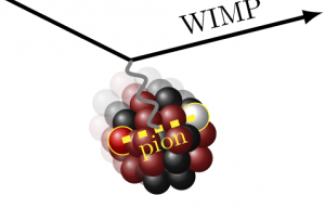In this and a companion paper, Phys. Rev. D 49, 3352 (1994), Larry McLerran and Raju Venugopalan proposed a classical model for the scattering of large nuclei at high energies. They argued that the color charges of the valence quarks can be treated as static sources which propagate along the light cone. A high density of soft gluons is generated, and can be described as a classical gauge field. This provides an energy scale much larger than the usual QCD scale, and so a small QCD coupling.
News and Announcements

The Muon g-2 Theory Initiative released an extensive review of the Standard Model prediction for the anomalous magnetic moment of the muon. This community-wide consensus was developed in a series of workshops over the last 3 years, the latest hosted by the INT in September 2019, involving key discussions that led to the recommendations in the white paper. The final value differs from the Brookhaven measurement by 3.7 standard deviations and sets the benchmark for the highly anticipated results from the Fermilab E989 experiment.

Jarzynski is well known for developing an equation to express the second law of thermodynamics for systems at the molecular scale while he was a post-doc at the INT. The equation is known as the Jarzynski equality. Published in the journal Physical Review Letters in 1997, the paper that introduced his equation has been cited in scientific literature more than 4,000 times.

The Nuclear Science Advisory Committee (NSAC) Subcommittee on Quantum Information Science (QIS) released its report in early November, Nuclear Physics and Quantum Information Science. David Hertzog, who leads UW’s Center for Experimental Nuclear Physics and Astrophysics (CENPA) is the Chair of NSAC, and the National Institute for Nuclear Theory’s (INT) and UW's Martin Savage is Chair of the QIS Subcommittee.
Among the experimental, theoretical and computational nuclear physics research activities, the report identifies capabilities and expertise unique to nuclear physics that will advance QIS. Similarly, it identifies nuclear physics scientific objectives and grand challenges expected to benefit from present and future developments in QIS. The work of the nuclear physics community in these areas can support strongly, and on strategic timescales, a national program established by the National Quantum Initiative.

In this work, we have searched for the interaction of dark matter particles with pions in atomic nuclei, manifested as characteristic xenon nuclear recoils in the XENON1T data. Our analysis finds no evidence for a dark matter-pion interaction, but sets the first limit on its strength. Previous analyses only considered the interaction of dark matter with individual nucleons, but nucleons interact due to the strong nuclear force, which arises for example from the exchange of virtual pions. A putative dark matter particle could then scatter off these pions, an interaction we have constrained for the first time.

